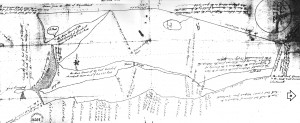Federal Period (1775-1830)
This period marks the transition of Westport as an independent town apart from Dartmouth and the establishment of its geographic boundaries. Westport was incorporated on July 2, 1787, and land was added from Dartmouth in 1793, 1795, and 1805. The present-day boundary between Westport and Dartmouth was established in 1828 (MHC 1981a).
The new town of Westport remained a small farming community with several waterpowered grist, saw, corn, and fulling mills. Westport town records indicate that the first townhouse was erected in 1789 on land owned by Stephen Kirby. Town historian Norma Judson reported that the actual site was located at the corner of Main and Adamsville roads on land belonging to Ichabod Potter (personal communication 2004). A map of the new town depicts the river crossing at Hix Bridge and the more general route of Old County Road, as well as a windmill near Westport Point, the
Friends meeting house at Central Village, and gristmills south of Cadman’s Neck and on Bread and Cheese Brook. The map also depicts five different mills at the Head of Westport, including two saw- and two gristmills and a forge.
By the mid-eighteenth century, a large number of Quakers established a social center at Central Village, south of the Head of Westport (MHC 1981a). The area’s Quakers eventually broke from the Dartmouth Monthly Meeting to establish the Acoaxet Monthly Meeting in 1766 (Ellis 1892), effectively laying the groundwork for the separation of Westport from Dartmouth in 1787. The first town meeting was held on August 20, 1787 in the home of William Gifford and included William Almy, Edward Borden, Thomas Tripp, and Richard Kirby (Westport Town Records 1787). Almy would later serve as the Westport representative to the state convention, voting in favor of the proposed United States constitution (Smith et al. 1976).
At Westport Point, an active fishing industry began in 1775, and by the early nineteenth century it had become an active whaling port. The first whaling voyage on record from Westport Point occurred in 1806. By 1836, five whaling ships were recorded. The development of fishing and whaling led to the establishment of support industries including shipyards, sail lofts, cooper shops, blacksmiths, and other businesses at Westport Point and the Head of Westport (MHC 1981a).
The Westport Cotton Manufacturing Company was started in 1812, effectively creating the area on the Westport/Dartmouth border that would become known as Westport Factory. The increased demand for products in New Bedford also led to the development of additional mills and the expansion of existing operations in the northeastern section of Westport, including an iron forge initiated in 1789 by William Gifford, Lemuel Milk, and Josiah Leonard (MHC 1981a).
Westport’s most famous resident during this period was Paul Cuffe (1759–1817), son of an African-American father and Native American mother. Cuffe, a successful cod fisherman and entrepreneur, established his farm along the East Branch where he built his home as well as a wharf and storehouses (Smith et al. 1976). Instrumental in providing the franchise to non-whites in Massachusetts, Cuffe also conceived the Back-to-Africa movement, a program through which freed slaves could return to Africa to establish a new, liberated nation. This plan was largely unsuccessful, but did succeed in galvanizing opposition among many New Englanders, black and white, against the practice of slavery.
Census records from this period help to interpret Westport’s evolution as a town. The 1780 federal census (taken before the separation of New Bedford and Westport) lists 841 houses in the town and 1,342 heads of household. Agricultural land use patterns are clearly tied more to animal husbandry than farming, with 10,000 acres listed as pasture, 7,500 acres listed as mowed, and only 2,700 acres listed as tilled land (Glennon 2001:204). The federal census taken in 1790 (after Westport separated from Dartmouth) identified 2,845 residents in Westport, including 1,134 white males over the age of 16, 1,176 white females over the age of 16, 495 white males under 16, and 40 “other free persons” including the families of Paul and John Cuffe (U.S. Bureau of the Census 1908). Although a category exists, the census does not identify any slaves in Westport. The census also does not count females under the age of 16.

